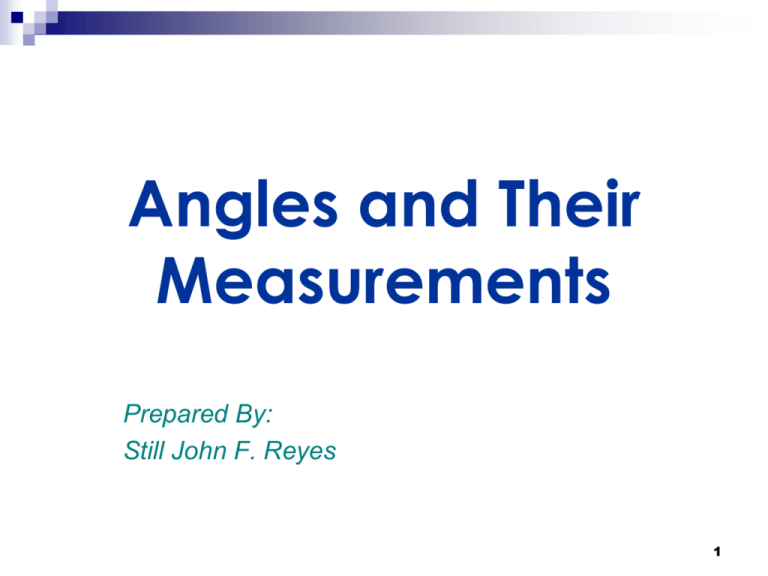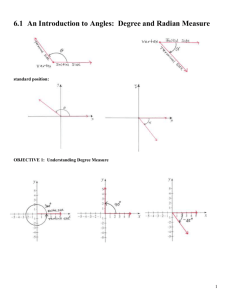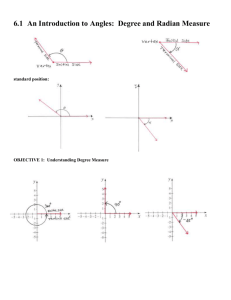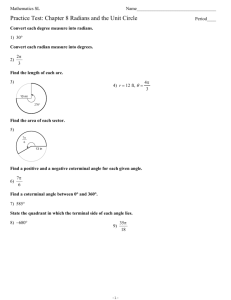
Angles and Their
Measurements
Prepared By:
Still John F. Reyes
1
Rectangular Coordinate System
Definitions
•
•
•
•
•
•
•
X-axis – the horizontal axis
Y –axis – the vertical axis
Rectangular coordinate system: where the xaxis and the y-axis intersect
Ordered pair: identifies the location of a point on
the rectangular coordinate system
(x coordinate, y coordinate)
Origin: (0,0) – intersection of the x and y axis
Quadrant: a section of the rectangular
coordinate system
2
3
How to graph a point?
First Locate the origin
Second, graph your x
-coordinate:
IF
the value of your x
coordinate is positive
move to the right, if
negative move to the
left
Third, graph your y coordinate:
IF
the value of your ycoordinate is positive
move up, if negative
move down
How to identify the quadrant?
First – locate where
your point is
Second – check your
graph on which
quadrant it is in.
In this section, we will study the following topics:
Terminology used to describe angles
Degree measure of an angle
Radian measure of an angle
Converting between radian and degree measure
Coterminal angles
Angles in a triangle
6
Angles
Section 4.1, Figure 4.1, Terminal and
Initial Side of an Angle , pg. 248
Angle Measure
Copyright © Houghton Mifflin Company. All rights reserved.
Digital Figures, 4–2
7
Standard Position
Section 4.1, Figure 4.2, Standard
Position of an Angle, pg. 248
Vertex at origin
Copyright © Houghton Mifflin Company. All rights reserved.
The initial side of an angle
in standard position is always located
on the positive x-axis.
Digital Figures, 4–3
8
Positive and
negative
4.3, Positive and
4.1, Figureangles
Section
Negative Angles, pg. 248
When sketching angles,
always use an arrow to
show direction.
Copyright © Houghton Mifflin Company. All rights reserved.
Digital Figures, 4–4
9
Measuring Angles
The measure of an angle is determined by the
amount of rotation from the initial side to the
terminal side.
There are two common ways to measure angles, in
degrees and in radians.
We’ll start with degrees, denoted by the symbol º.
1
360
One degree (1º) is equivalent to a rotation of
of one revolution.
10
Section 4.1, Figure 4.13, Common Degree
Measures on the Unit Circle, pg. 251
Measuring Angles
1
360
Copyright © Houghton Mifflin Company. All rights reserved.
Digital Figures, 4–9
11
Classifying Angles
Angles are often classified according to the quadrant
in which their terminal sides lie.
Ex: Name the quadrant in which each angle lies.
50º
Quadrant 1
208º
Quadrant 3
II
I
-75º
Quadrant 4
III
IV
12
Classifying Angles
Standard position angles that have their terminal
side on one of the axes are called quadrantal
angles.
For example, 0º, 90º, 180º, 270º, 360º, … are
quadrantal angles.
13
Coterminal Angles
AnglesSection
that have
theFigure
same 4.4,
initial
and terminal
4.1,
Coterminal
Angles, pg. 248
sides are coterminal.
Angles and are coterminal.
Copyright © Houghton Mifflin Company. All rights reserved.
Digital Figures, 4–5
14
Example of Finding Coterminal Angles
You can find an angle that is coterminal to a given angle
by adding or subtracting multiples of 360º.
Ex:
Find one positive and one negative angle that are
coterminal to 112º.
For a positive coterminal angle, add 360º : 112º + 360º = 472º
For a negative coterminal angle, subtract 360º: 112º - 360º = -248º
15
Degree System of Angular Measure
1° (one degree) = 60’ (60 minutes)
1’ (one minute) = 60” (60 seconds)
360° (360 degrees) = 1 revolution
There are two ways of measuring angles:
1. Degrees, Minutes, Seconds (DMS)
2. Decimal Degrees
Examples:
Express each angle measure using DMS
1) 10.5°
2) 42.72°
Express the ff. in decimal degrees
1) 95° 45’ 45”
Exercises
1.
2.
3.
4.
Find one positive and one negative angle
that is coterminal with the angle = 30°
in standard position.
Find one positive and one negative angle
that is coterminal with the angle = 272
in standard position.
Express 27.3° using DMS.
Express 28° 18’ 36” in decimal degrees.
18
Do Worksheet 1
19
Radian Measure
A second way to measure angles is in radians.
Definition of Radian:
One radian
is the4.1,
measure
a central
angleof that intercepts
Section
Figureof4.5,
Illustration
arc s equal in length
to the radius
r of the circle.
Arc Length,
pg. 249
In general,
s
r
Copyright © Houghton Mifflin Company. All rights reserved.
Digital Figures, 4–6
20
Radian Measure
2 radians corresponds to 360
2 6.28
3.14
radians corresponds to 180
Section 4.1,
radians corresponds
toFigure
90 4.6, Illustration of 1.57
Six Radian Lengths, pg. 249 2
2
Copyright © Houghton Mifflin Company. All rights reserved.
Digital Figures, 4–7
21
Section 4.1, Figure 4.7, Common
Radian Measure
Radian Angles, pg. 249
22
Conversions Between Degrees and Radians
1.
To convert degrees to radians, multiply
degrees by
180
2.
To convert radians to degrees, multiply
radians by 180
23
Ex. Convert the degrees to radian measure.
a)
60
b)
30
Ex. Convert the radians to degrees.
a)
rad
6
b)
rad
2
Ex. Find one positive and one negative angle that is
coterminal with the angle =
in standard position.
3
Ex. Find one positive and one negative angle that is
7
coterminal with the angle =
in standard position.
5
Interior Angles of a Triangle
The sum of the interior angles of any
triangle is 180°.
In a right triangle, the sum of the acute
angles is 90°. The two angles are said to
be complementary angles.
Two angles with a sum of 180° is said to
be supplementary angles.
27
Examples
1)
2)
Given: ∆ABC, if angle A=95°, angle
B=45°, find angle C.
Given: ∆ABC is a right triangle and angle
B=46° 20’, find angle A.
28
Exercises
29
Applications of Angle
Measures
30
Arc Length and Central Angles
s r
s arc length (length of the intercepte d arc)
central angle measured in radians
r radius
Example
Find
the measure of a rotation in radians
when a point 2 m from the center of
rotation travels 4 m.
s r
4 2
2
Example
Find
the length of an arc of a circle of
radius 5 cm associated with an angle of
/3 radians.
s r
s 5
3
5
s
3
Linear & Angular Velocity
Things that turn have both a
linear velocity and an angular velocity.
Linear Velocity
Definition:
Linear Velocity is distance/time:
Linear
Speed
s
v
t
Distance
Time
Angular Velocity
Definition:
Angular Velocity is turn/time:
Angular
Speed
(omega)
t
Rotation in
radians
Time
Linear & Angular Velocity
Definition of Linear Velocity:
Recall Arc Length Formula
Linear Velocity in terms of Angular Velocity:
s
v
t
r
v
t
v r
Let us take 2 pendulums hung on a
slim rotating rod for analysis.
If the 2 pendulums (A and B) rotate one
full cycle, the time taken by them is the
same.
They covered the same amount of
angular distance (360 degree) within the
same amount of time.
This showed that they have exactly
the SAME angular speed.
But is the Linear speed the same?
Let us take 2 pendulums hung on a
slim rotating rod for analysis.
The length of the 2 circumferences
travelled by the individual pendulums
are not the same.
The linear length or distance is
therefore NOT the same.
Length = 2 x (pi) x radius = 2πr
They took the same time to complete
one full cycle, though.
The linear speed is thus DIFFERENT,
having travelled different length for the
same amount of time.
Example:
A satellite traveling in a circular
orbit approximately 1800 km.
above the surface of Earth
takes 2.5 hrs. to make an orbit.
The radius of the earth is
approximately 6400 km.
a) Approximate the linear speed
of the satellite in kilometers per
hour.
b) Approximate the distance the
satellite travels in 3.5 hrs.
1800 km
6400 km
Earth
Not to scale
Example:
r = 6400 + 1800 = 8200
t = 2.5 hrs.
a) Approximate the linear speed
of the satellite in kilometers per
hour.
r
v
t
82002
v
2 .5
v 6560 km / hr
1800 km
6400 km
Earth
Not to scale
Example:
r = 6400 + 1800 = 8200
v 6560 km / hr
t = 2.5 hrs.
b) Approximate the distance the
satellite travels in 3.5 hrs.
s
v
t
s
6560
3.5
s 22960 km
1800 km
6400 km
Earth
Not to scale
A small pulley 6 cm in diameter is
connected by a belt to a larger pulley
15cm in diameter. The small pulley is
turning at 120 revolutions/rotations per
minute (rpm).
a)
b)
Find the angular velocity of the small pulley in
radians per second.
Find the linear velocity of the rim of the small
pulley.
A small pulley 6 cm in diameter is
connected by a belt to a larger pulley
15cm in diameter. The small pulley is
turning at 120 rpm.
a)
Find the angular velocity of the small pulley in
radians per second.
120 rotations
2
1 min
1 min
1rotation 60 sec
4 radians / sec
A small pulley 6 cm in diameter is
connected by a belt to a larger pulley
15cm in diameter. The small pulley is
turning at 120 rpm.
4 radians / sec
b)
Find the linear velocity of the rim of the small
v r
pulley.
v 3cm4 radians / sec
v 12 cm / sec
Exercises
1.
2.
3.
Find the length of the arc intercepted by a
central angle of measure 2.5 radians in a
circle whose radius is 15 cm.
A central angle of 38° intercepts an arc of
5 meters. Find the radius of the circle.
A flywheel 6 ft. in diameter makes 40
rpm.
Find its angular velocity in radians per
second.
b. Find the speed of the belt that drives the
flywheel.
a.
46
Do Worksheet 2
47






